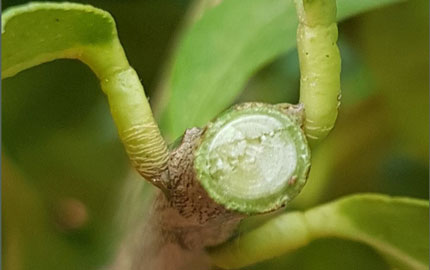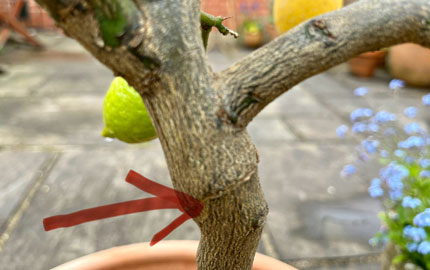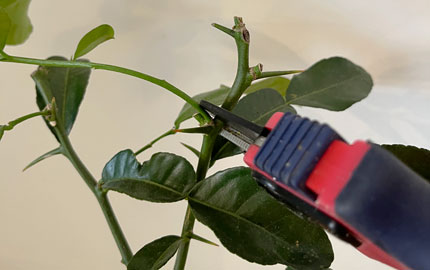How and when to prune your citrus tree?
When to prune
You can prune citrus at any time of year but in the spring you want to be mindful of pruning off the new spring flower buds and affected the harvest later in the year. You don't need to prune citrus trees every year but you might choose to prune a tree because one of the branches is damaged, because it has got a bit too big for it's current position or because you want to improve the overall shape of the tree. This page will take you through our top tips on pruning for shape and long term health.
If your plant has dropped some or lots of leaves due to under or overwatering or if it's been caught out in a cold spell then please do also see our videos on pruning for frost damage here. These videos show clearly how and where to cut and go into more detail about removing larger areas of damaged or frosted growth. They were filmed particularly in relation to frost damage but the same principles apply for any stress event and leaf loss.
Where to cut?
Pruning citrus is actually pretty easy to do. The main thing you need to know is where to cut. Like roses, you always want to cut just above a growing joint, or leaf node, a leaf node is a part of the branch where a leaf, fruit or another branch has grown. Even if you are left with bare branches you can still find these growing joints because leaf drop will always leave a little scar on the branch. In the picture below, you see the light green bump just above the scar, that is new growth just starting to form. When making your cut, use sharp secateurs and leave a couple of millimetres above the scar. Cut at a 45-degree angle, so the top is next to the scar/bud and it slopes down on the opposite side of the scar/bud, so that new growth can form.


When you make a fresh cut you should see a healthy green ring just under the bark as pictured. The green ring is the vascular cambium, the living cells inside the plant that help to form growth. This will fade quickly after cutting the tree and dry out, so once you have pruned the tree to a good shape don’t panic that this colouring has gone.
By cutting at the leaf node you are cutting at the point where there are the most growth hormones and the best chance of promoting new growth. From each cut you would expect to get one or two side shoots, so over time regular pruning will make your tree look bushier.
How much to prune?
How much to prune is a bit more tricky. It is a bit of a fine balance, you cut off too much and it will take longer to grow, too little and the growth will mainly come from the top of the branches and you will have bare gaps in the middle of the tree. You want to start by cutting off any broken or crossing branches and dead brown stumps or lifeless twigs. If your tree has grown a bit big for it's current position you can take up to two thirds of the growth of any or all of the branches. We'd normally recommend that you prune all the branches back to a similar length so they form an arch over the top of the trunk that will give the new growth a nice structure to grow from. You can always reshape the branches at a later date but getting a good base will help the tree look much prettier long term. Bear in mind that vigorous varieties like lemons and grapefruits can grow 30-60cm(1-2 foot) a year, whereas dwarf varieties like calamondins usually grow more like 10-20cm a year. To achieve an ultra neat topiary style tree you would be best to prune just a small amount 2-3 times a year. For a more relaxed and natural looking tree shape we'd normally recommend a prune either once a year or just as and when the growth demands.
What is a water shoot?
Occasionally citrus trees can put on one very strong and fast growing branch, typically with larger or slightly differently shaped leaves. These are called a water shoot. They can make the tree look a bit lopsided but more importantly they grow so quickly, they draw too much of the trees nutrient and water reserves, leaving none for the rest of the tree or developing fruits. If you do notice an odd branch that grows very quickly compared to the rest of the tree then actually this over vigorous off shoot should actually be cut right back to it's source at the trunk to ensure healthy and balanced long term growth of the tree.
What about growth below the graft point?
Grafted trees combine a strong root stock with a top graft which produces the fruit or characteristics of the variety and ensures potted citrus trees will reliably fruit even a young age. The root stock is chosen for it's growth pattern and disease and cold resistance and most of our citrus trees are grafted on either poncirus trifolate, citrus hystrix or lemon volkamer root stock. You can spot the graft by looking for a bulge or scaring on the plant usually about 20-60cm above the soil level and often the main point from which the plant branches. Any growth below the graft point will be taking nutrients from the top graft and damaging the plants long term fruit production. It does feel really harsh but if you do see leaf growth below the graft point this should be cut right back to the trunk as soon as possible. This allows the plants energy and nutrients to go through the graft back to the main tree and into producing new leaves, flowers and fruits. The only exception would be if the top of the tree has completely failed, perhaps through cold or extreme stress. If the whole top of the tree is dead but the plant is putting on new growth from the roots you might choose to grow and enjoy the original root stock as a new plant. Of course when a tree reverts like this too the original variety of the rootstock it is no longer a grafted tree and it is very unlikely to fruit.

 Find the graft point by looking for swelling or scarring on the trunk; removing leafless twigs helps tidy the tree and stimulate new growth.
Find the graft point by looking for swelling or scarring on the trunk; removing leafless twigs helps tidy the tree and stimulate new growth.
For more general tips on citrus care don't miss our Top tips video and full page all about positioning and watering citrus trees here
Love your citrus tree and want a companion for it?
Don't forget to check out our full range of beautiful citrus trees for sale

